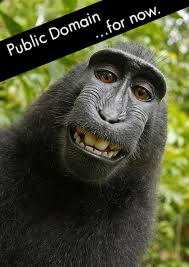
Nature photographer David Slater is in an ongoing copyright dispute with the Wikimedia Foundation over the first recorded example of selfies in the wild. While in Indonesia in 2011, Mr. Slater was photographing a group of mischievous black crested macaques. According to his report, he was pursuing an elusive shot of one of the animals “full in the face”. He realized that in order to achieve that, the monkeys would need to feel comfortable enough with the equipment for a close approach. Mr. Slater explains that he then set up a tripod with a cable release, and allowed the monkeys to explore the equipment, see their reflections in the camera, and press the shutter themselves. One noteworthy result of the photo session was a riveting close-up headshot of one of the macaques; another was a good deal of talk on the nature of copyright of this monkey selfie and other similarly non-traditional work.
At some point after the image was captured, it was uploaded to Wikimedia Commons without Mr. Slater’s consent, and it remains there to this day freely available to the public. Initially, Mr. Slater requested that Wikimedia remove the photograph as he claimed ownership and opposed the public domain position taken by the site when it came to hosting his image. Wikimedia refused, and Mr. Slater followed up with a lawsuit claiming a significant loss of income, upwards of $30,000, as he was not able to profit from subsequent use of the photo. The basic claim of Wikimedia is that “the file is in the public domain because, as the work of a non-human animal, it has no human author in whom copyright is vested.” (The Copyright Act of 1976 did not cover—or anticipate—works created by any beings other than humans.) Slater’s argument is that it was his artistic and technical vision of setting up the shot, and arranging all the components that allowed this image to emerge, irrespective of the fact that the monkey actually clicked the shutter. According to Mr. Slater, all of his wildlife photographs constitute “original works of authorship,” the basic criterion for copyright, and therefore, by extension, he claims ownership of the photograph in question as well. The photographer’s website is plastered with the now-famous photo and references to this selfie saga, including rally cries such as “Help me change Copyright Law” and “Google Images is NOT a free source for image theives [sic]! Don't break the law.”
The strange process by which this photograph emerged brought us to the current debate. While it is unlikely that such a precise confluence of events would again occur in the future, there are some implications for the broader audience. Indeed, the outcome of this legal action may lead Wikimedia to be more careful in their goal to “bring about a world in which every single human being can freely share in the sum of all knowledge.” This mission may be at odds with the value placed on those who actually generate original works of authorship. By not appreciating the artist’s creative contribution, Wikimedia may frustrate the artists in question, and eventually stifle the very creativity and sharing of knowledge that they wish to proliferate.
At some point after the image was captured, it was uploaded to Wikimedia Commons without Mr. Slater’s consent, and it remains there to this day freely available to the public. Initially, Mr. Slater requested that Wikimedia remove the photograph as he claimed ownership and opposed the public domain position taken by the site when it came to hosting his image. Wikimedia refused, and Mr. Slater followed up with a lawsuit claiming a significant loss of income, upwards of $30,000, as he was not able to profit from subsequent use of the photo. The basic claim of Wikimedia is that “the file is in the public domain because, as the work of a non-human animal, it has no human author in whom copyright is vested.” (The Copyright Act of 1976 did not cover—or anticipate—works created by any beings other than humans.) Slater’s argument is that it was his artistic and technical vision of setting up the shot, and arranging all the components that allowed this image to emerge, irrespective of the fact that the monkey actually clicked the shutter. According to Mr. Slater, all of his wildlife photographs constitute “original works of authorship,” the basic criterion for copyright, and therefore, by extension, he claims ownership of the photograph in question as well. The photographer’s website is plastered with the now-famous photo and references to this selfie saga, including rally cries such as “Help me change Copyright Law” and “Google Images is NOT a free source for image theives [sic]! Don't break the law.”
The strange process by which this photograph emerged brought us to the current debate. While it is unlikely that such a precise confluence of events would again occur in the future, there are some implications for the broader audience. Indeed, the outcome of this legal action may lead Wikimedia to be more careful in their goal to “bring about a world in which every single human being can freely share in the sum of all knowledge.” This mission may be at odds with the value placed on those who actually generate original works of authorship. By not appreciating the artist’s creative contribution, Wikimedia may frustrate the artists in question, and eventually stifle the very creativity and sharing of knowledge that they wish to proliferate.
